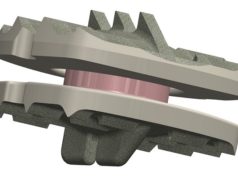
Preliminary results of an Investigational Device Exemption (IDE) study into two-level cervical total disc replacement (TDR) using a polyetheretherketone (PEEK)-on-ceramic implant (Simplify Medical), showed that the device is associated with significant decreases in pain and disability scores. The findings were presented by Richard Guyer (Texas Back Institute, Plano, USA) at the International Society for the Advancement of Spine Surgery annual meeting (ISASS20; 26–28 February, Puerto Rico, USA).
During his presentation, Guyer noted that to date, good results have been reported for a variety of cervical TDRs, which have most commonly been made of a variety of metallic endplates with a plastic core and that some metal-on-metal devices have also been described. Guyer added that while there are multiple prospective studies reporting on one-level TDR, there is much less prospective data available for two-level procedures. The use of PEEK for spinal implants is increasing, he said, primarily due to its mechanical properties and favourable imaging properties. The Simplify TDR implants investigated through the trial are with titanium-coated PEEK endplates with a biconvex zirconia toughened alumina ceramic core.
The results presented by Guyer came from three of 18 sites in the USA participating in the IDE study for the PEEK-on-ceramic TDR for two-level cervical disc generation. In total, 62 patients were implanted with the device, and 12-month follow-up data were available fo this study sample. Outcome measures assessed included the Neck Disability Index (NDI), visual analogue scales (VAS) separately assessing neck and arm pain, and disc height of the operated segments measured from radiographs, analysed by an independent lab specialising in image assessment. Evaluations were conducted prior to surgery and at six weeks, and three, six, and 12 months after surgery.
Outlining the results, Guyer noted that there were decreases (p<0.01) in NDI at 12 months (n=62). Mean VAS neck pain scores improved significantly (p<0.01) at 12 months. Improvements in mean VAS arm pain scores were also measured, having stood at 5.3 (right) and 5.1 (left) at the pre-operative and 1.1 (right) and 0.6 (left) at 12 months. The mean disc height at both implanted levels also increased early post-operatively and was maintained right through to the 12-month follow-up, Guyer reported. Flexion/extension range of motion (ROM) at the inferior level was significantly increased (p<0.05), from 6.1 at the pre-operative stage to 7.1 at six weeks, and remained at an improved level through to 12 months (8.7). ROM at the superior level increased, Guyer noted, from 8.4 pre-operatively, but not significantly so, measuring 7.6 at six weeks and 9.4 at 12 months.
Guyer said that the early study results suggests that PEEK-on-ceramic TDR devices may be a future consideration for the treatment of symptoms arising from two-level degenerative conditions of the cervical spine, due to the decreases in pain and function scores compared to the pre-operative values, which were maintained through 12-month follow-up.













